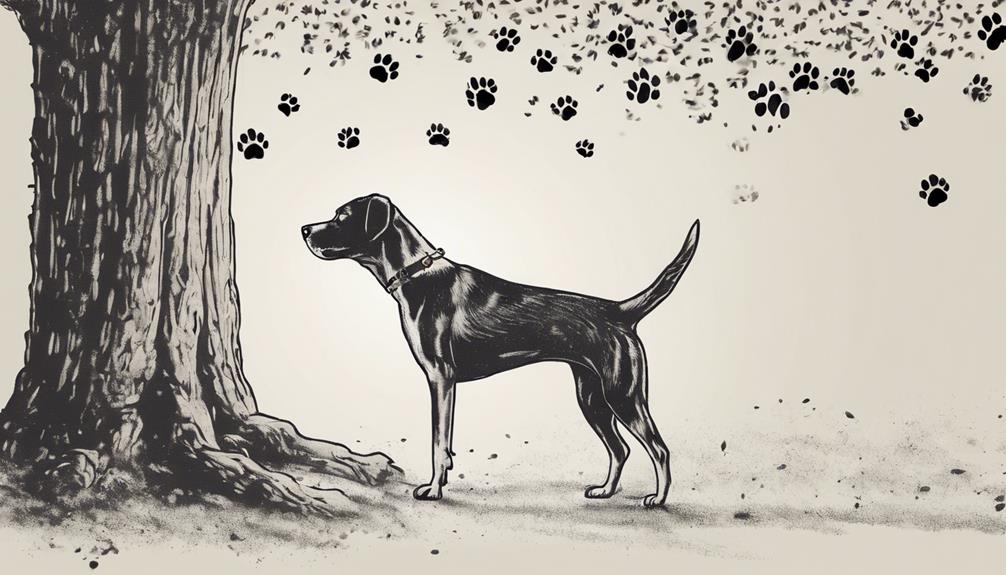4 Best Ways Dogs Convey Messages to Humans
When it comes to communication, dogs have a myriad of ways to speak to you without saying a word. Their body language is like a silent symphony, with each movement carrying a specific message.
But that's just the tip of the iceberg. From the way they bark to their tail wagging and even their subtle facial expressions, dogs have a whole dictionary of communication waiting for you to decipher.
Understanding these cues can deepen your bond with your furry friend in ways you never imagined.
Body Language
When observing your dog, pay close attention to their body language as it's a key way they convey messages. The positioning of their ears can tell you a lot about how they're feeling. Ears perked up suggest alertness and interest, while flattened ears indicate fear or submission. Additionally, their posture is crucial. A relaxed and loose posture signifies comfort and happiness, while a tense body may signal anxiety or aggression.
Dogs communicate through movement and gestures as well. Wagging tails are often associated with happiness, but it's essential to consider the speed and height of the wag. Slow, low wags may indicate insecurity or wariness. Likewise, a tucked tail suggests fear or submissiveness. Pay attention to your dog's overall body language to interpret their emotions accurately.
Barking
Pay attention to your dog's barking as it's another crucial way they communicate messages to you. Dogs use barking as a form of communication, and deciphering the meaning behind their barks can help you better understand what they're trying to convey. Here are some key points to consider when interpreting your dog's barking:
- Bark translation: Different types of barks can indicate various messages. For example, a sharp and short bark may signal alertness or warning, while a continuous and high-pitched bark could indicate anxiety or distress.
- Communication cues: Pay attention to the context in which your dog is barking. Are they looking at something outside the window, near their food bowl, or when a stranger approaches? Understanding the trigger can provide valuable insights into what your dog is trying to communicate.
- Tone and pitch: The tone and pitch of your dog's barks can also convey emotions. A playful bark may sound different from a fearful or aggressive bark, helping you gauge their mood.
- Consistency: Consistent patterns in your dog's barking can also offer clues. For instance, if they bark every time the doorbell rings, it may indicate excitement or a desire to alert you of someone's presence.
Tail Wagging
Interpreting your dog's tail wagging can provide valuable insights into their emotions and intentions. The speed at which your dog wags its tail can indicate different feelings. A fast wag usually signifies excitement or happiness, while a slow wag might suggest uncertainty or caution. Paying attention to the wagging speed can help you gauge your dog's current state of mind.
Another crucial aspect to consider is the position of your dog's tail while wagging. A tail held high while wagging often indicates confidence and a positive attitude. On the other hand, a tail tucked between the legs during wagging can signal fear or submission. Observing the tail position along with the wagging speed can give you a more accurate understanding of what your dog is trying to communicate.
Next time your furry friend greets you with a wagging tail, take note of both the speed and position to better comprehend their emotions and intentions.
Facial Expressions
To understand your dog better, observe their facial expressions as they can provide valuable insights into their emotions and communication. Dogs use a wide range of facial expressions as communication cues, allowing you to decipher what they might be feeling or trying to convey.
Here are some key facial expressions to look out for:
- Relaxed Face: A relaxed face with soft eyes and a slightly open mouth usually indicates your dog is calm and content.
- Raised Eyebrows: When your dog raises their eyebrows, it can signify excitement or curiosity about something in their environment.
- Yawning: Contrary to popular belief, dogs don't always yawn because they're tired. A yawn can also indicate stress or discomfort.
- Lip Licking: Dogs often lick their lips when they're feeling anxious or uncertain about a situation, signaling their unease.
Eye Contact
When engaging with your dog, maintaining eye contact can deepen your bond and enhance communication. Dogs use eye contact as a way to convey various messages to you. It serves as a key element in understanding training cues and behavioral cues your dog may be giving you. By establishing eye contact, you can pick up on your dog's social cues and communication signals more effectively.
For instance, prolonged eye contact can indicate a strong emotional connection or a sign of trust from your dog. On the other hand, averted eyes could signify submission or discomfort in certain situations. Understanding these subtle cues through eye contact can help you respond appropriately to your dog's needs and feelings.
In training scenarios, maintaining eye contact can help reinforce positive behaviors and strengthen your dog's focus. Additionally, during everyday interactions, eye contact serves as a powerful tool to build a deeper connection and mutual understanding between you and your furry companion.
Vocalizations
Maintaining eye contact with your dog offers valuable insights into their emotions and intentions, and now we'll explore how dogs use vocalizations to convey messages. Dogs employ a variety of vocal cues to communicate with humans, often expressing their needs, feelings, and warnings through different sounds.
Here are four ways dogs use vocalizations to convey messages:
- Growling warning: When a dog growls, it's essential to pay attention as it can signify discomfort, fear, or a warning to back off. Understanding the context and body language accompanying the growl is crucial in interpreting the message accurately.
- Whining attention: Dogs may whine to seek attention, convey stress, or express excitement. It's essential to observe the situation to determine the reason behind the whining and respond accordingly to address your dog's needs effectively.
Scent Marking

Dogs communicate important information through scent marking, a behavior that plays a significant role in their social interactions and territory claiming. When your canine friend engages in scent marking, they aren't just leaving their scent behind; they're also engaging in pheromone communication. Through scent marking, dogs release pheromones that convey messages to other dogs in the area. These messages can indicate information about the marker's identity, reproductive status, and even emotional state.
Territorial behavior is a key driver behind scent marking. By leaving their scent in specific locations, dogs are marking their territory and communicating to other animals that the area is claimed. This helps establish boundaries and can prevent conflicts between dogs competing for the same space. In a multi-dog household, understanding your pets' scent marking behaviors can help you manage their interactions and create a harmonious living environment. So, next time you notice your dog engaging in scent marking, remember that they're using this natural behavior to convey important messages to those around them.
Physical Touch
After understanding how dogs use scent marking to convey messages, let's explore how physical touch plays a crucial role in their communication and social interactions. Dogs often use physical touch to express their needs, emotions, and strengthen bonds with humans.
Here are some ways dogs use physical touch to communicate effectively:
- Pawing Behavior: Dogs may paw at you as a way to seek attention, ask for food, or indicate they want to go outside. This gentle touch can convey various messages depending on the context.
- Cuddling Cues: When dogs snuggle up close to you or lay their head on your lap, they're showing affection and seeking comfort. This physical closeness helps them feel secure and connected to their human family members.
- Nudging: Dogs may nudge you with their nose to initiate playtime, request petting, or simply to interact with you. This tactile interaction is a way for them to engage and communicate their desires.
- Resting Against You: When a dog leans against you or rests their body on yours, it's a sign of trust and a way for them to bond with you through physical contact.
Frequently Asked Questions
Can Dogs Understand Human Emotions and Expressions?
Dogs have an incredible ability to understand human emotions and expressions. Through canine empathy, they can pick up on your feelings and react accordingly. This strengthens the human-animal bond, as they respond to your emotional cues with nonverbal communication.
Whether you're happy, sad, or stressed, your furry friend is often there to support you and share in your experiences. Their sensitivity to your emotions is a special trait that enhances the unique connection between dogs and humans.
How Do Dogs Show Affection Towards Their Owners?
Dogs show affection towards their owners in various ways. Tail wagging, licking, playful nudges, and cuddling are common signs of their love for you. These actions convey their happiness, attachment, and desire for closeness.
When your furry friend wags their tail enthusiastically or gives you slobbery kisses, it's their way of expressing their affection and bonding with you. Embrace these gestures as your pup's heartfelt way of showing how much they care about you.
Do Different Breeds of Dogs Have Different Ways of Communicating With Humans?
Different breeds of dogs do indeed have breed-specific behaviors that influence how they communicate with humans. These differences can affect canine interactions with you as their owner. Understanding these breed-specific traits can help you interpret your dog's communication better and strengthen your bond.
What Are Some Signs That a Dog Is Feeling Anxious or Stressed?
If your furry friend is feeling anxious or stressed, they may show it through various warning signs. Keep an eye out for stress indicators in their body language.
Typical signs of canine anxiety include panting, pacing, drooling, and excessive licking. Watch for flattened ears, a tucked tail, or avoidance behavior.
Understanding these cues can help you provide comfort and support when your dog needs it most.
Can Dogs Communicate With Each Other Through Body Language and Vocalizations?
Dogs communicate with each other through a combination of body language and vocalizations. Canine communication is complex and nuanced, allowing them to convey a wide range of emotions and intentions to other dogs.
When interacting with humans, dogs use similar methods to express their needs and feelings. Understanding these interspecies interactions can help strengthen the bond between you and your furry friend.
Conclusion
Understanding how dogs communicate with humans is essential for building a strong bond with our furry friends. By paying attention to their body language, barking, tail wagging, facial expressions, eye contact, vocalizations, scent marking, and physical touch, we can better interpret their needs and emotions.
By being attentive and responsive to these signals, we can strengthen our relationship with our dogs and ensure a happy and healthy partnership for both parties.
